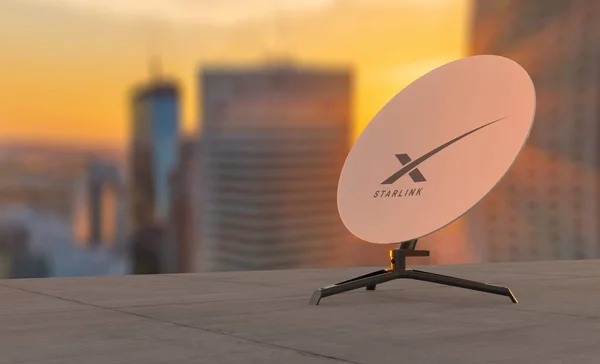Starlink: Revolutionizing Global Internet Connectivity
In a world where access to reliable internet is increasingly essential, Starlink has emerged as a game-changer. Launched by SpaceX, Starlink aims to provide high-speed internet to even the most remote areas on Earth. But what is it exactly, and how does it work? Let’s take a closer look at how Starlink is transforming the way we connect to the web.

What is Starlink?
Starlink is a satellite internet constellation being developed by SpaceX, the aerospace company founded by Elon Musk. Unlike traditional satellite internet, which relies on a small number of large satellites orbiting far from the Earth, Starlink uses thousands of smaller satellites positioned in low Earth orbit (LEO). These satellites work together to create a dense network that delivers faster internet speeds with lower latency.
How Does Starlink Work?
Traditional satellite internet services often suffer from high latency due to the distance that data must travel between the Earth and the satellite. Starlink addresses this issue by placing its satellites much closer to the Earth, roughly 340 miles (550 km) above the planet. This allows the service to significantly reduce latency, making it more comparable to cable or fiber-optic internet services.
The Starlink system consists of three main components:
- The Satellite Network: Thousands of small satellites orbiting the Earth in LEO.
- The Ground Station: User terminals, which look like small satellite dishes, connect directly to the satellite network.
- The Router: Once the user terminal receives the signal, the router distributes the internet connection to devices in the user’s home or business.
Benefits of Starlink
- Global Coverage: Starlink’s satellite network can provide internet access to virtually every corner of the planet, including areas that have historically been underserved by traditional internet providers, such as rural regions, ships at sea, and remote villages.
- High-Speed Connectivity: Starlink users can enjoy speeds ranging from 50 Mbps to 200 Mbps, with plans for higher speeds as more satellites are deployed. This makes it suitable for streaming, online gaming, and other high-bandwidth activities.
- Low Latency: With latency as low as 20 milliseconds, Starlink is ideal for activities that require real-time responses, such as video conferencing or online gaming. This is a significant improvement over traditional satellite services, which can have latency as high as 600 milliseconds.
- Fast Deployment: Unlike traditional infrastructure-heavy services that require extensive land-based infrastructure (e.g., cables, towers), Starlink can be set up in a matter of minutes using a user terminal and router. This makes it an excellent option for remote work, disaster response, and emergency situations.
Challenges Facing Starlink
While Starlink holds great promise, it’s not without its challenges:
- Cost: The initial cost of the Starlink kit, which includes the satellite dish and router, is around $599, with a monthly subscription fee of $110. This can be steep for some households, especially in developing countries.
- Satellite Congestion: As more satellites are launched, concerns about space debris and the risk of satellite collisions grow. SpaceX has worked to address these concerns by designing satellites that can deorbit themselves at the end of their life cycle, but it’s an issue that requires careful management.
- Regulatory Hurdles: Starlink must navigate various regulatory environments in different countries, and not all governments are open to the idea of privately owned satellite constellations providing internet access across borders.
The Future of Starlink
As Starlink continues to expand its constellation, the service is expected to become even more efficient and accessible. SpaceX has plans to launch tens of thousands more satellites to create a fully operational global internet service. Additionally, partnerships with airlines and other industries may make Starlink available in-flight, on ships, and in other mobile scenarios.
In the coming years, Starlink could help close the digital divide by bringing reliable, high-speed internet to areas that have been left behind by traditional ISPs. Whether you’re living in a rural area without access to fiber-optic cables or you’re in need of a reliable backup for your current internet service, Starlink is poised to redefine how the world connects.

Tech to Trick This is really interesting, You’re a very skilled blogger. I’ve joined your feed and look forward to seeking more of your magnificent post. Also, I’ve shared your site in my social networks!
Thank you so much for your generous compliment and for joining the feed! I’m thrilled to hear you’re enjoying the posts, and I truly appreciate you sharing the site with your network. Looking forward to providing more content you’ll love!
Thank you so much for your kind words and support! I’m glad you find the content interesting. I truly appreciate you joining the feed and sharing it with your network. Stay tuned for more posts, and feel free to share your thoughts anytime!
Tech to Trick This was beautiful Admin. Thank you for your reflections.
Thank you for your kind words! I’m glad you found the reflections meaningful. Your feedback is truly appreciated!
Nice blog here Also your site loads up very fast What host are you using Can I get your affiliate link to your host I wish my site loaded up as quickly as yours lol
Simply Sseven This was beautiful Admin. Thank you for your reflections.
Simply Sseven This is really interesting, You’re a very skilled blogger. I’ve joined your feed and look forward to seeking more of your magnificent post. Also, I’ve shared your site in my social networks!